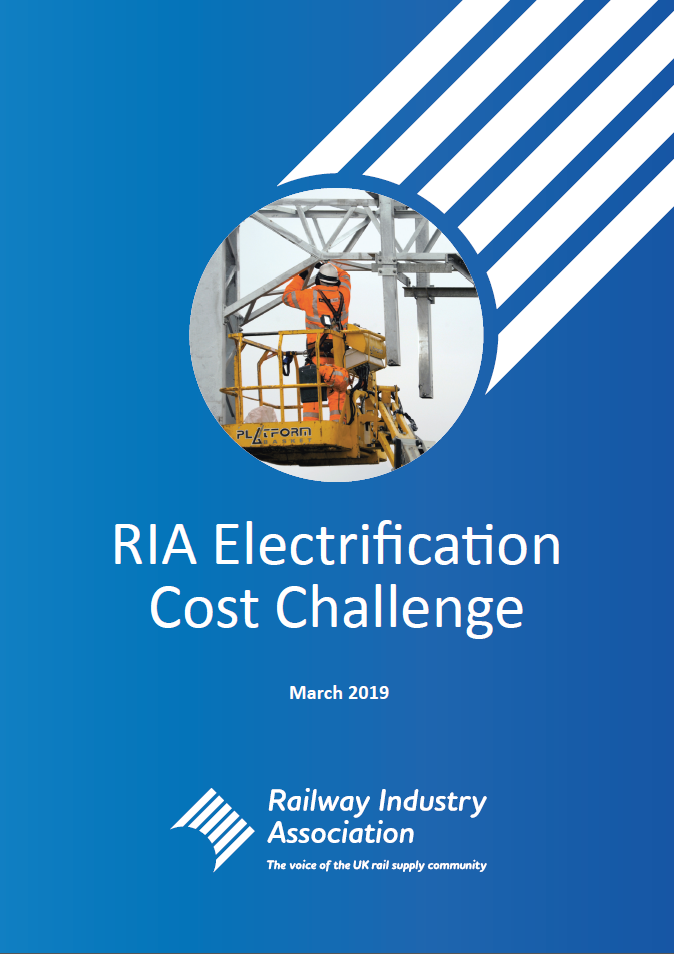The Electrification Cost Challenge report shows how future electrification schemes can be delivered at 33-50% lower cost.

The Electrification Cost Challenge (ECC) report uses examples from the UK and internationally to show that the high costs seen on recent projects, including the Great Western Electrification Programme, can be avoided in the future. It suggests that significant increase in cost on some past projects like Great Western should be seen as a one-off, caused by an unrealistic programme of work, unpreparedness in using novel technologies resulting in poor productivity and a ‘feast and famine’ electrification policy.
The purpose of the report is to:
- Set out the benefits of electrification for passengers and customers, and how it supports the Government’s Decarbonisation Challenge;
- Summarise UK electrification strategy since 2007;
- Discuss the Great Western Electrification Project (GWEP) and the reasons that it failed;
- Highlight the lessons that have been learnt; and
- Highlight evidence that electrification can be, and is being, delivered for between 33%-50% of the costs of some recent projects using examples from around the UK and internationally.
The report calls for the industry to come together with Government to ensure mistakes aren’t repeated and urges Government to renew its commitment to electrification, following the cancellation of a number of schemes in July 2017, by establishing a ten-year rolling programme, which will build up capabilities amongst rail businesses, thereby lowering long-term costs.
The report states that electrification is the optimal solution for intensively used rail lines and agrees with a recent report by the Rail Industry Decarbonisation Taskforce that electrification should be seen as the first choice in a hierarchy of options for decarbonising the rail network by 2040. Emerging technologies will also likely have a role to play for less intensively used passenger lines, including bimode, trimode, battery and hydrogen, but these alone can’t achieve the Government’s aim of decarbonising the rail network.
Download the report
Benefits of Electrification
Around 40% of the UK rail network is electrified - much less than comparable European countries which are typically 60% or more electrified. Electrified railways have been shown to benefit passengers and the wider travelling public as it is:
- Better for the environment with carbon emissions 60% lower than those from diesel trains today and 80% less with the estimated 2040 grid mix. They also produce no air pollutants at the point of use;
- Quieter, reducing noise pollution for those living and working near the tracks and reduces noise and vibration for passengers;
- Costs less in the long term when compared to the whole-life costs of diesel services;
- Improves journey times due to superior braking and acceleration;
- Is lighter, meaning less wear to the track and therefore less maintenance;
- Reduces passenger delays, as electric trains are more reliable than diesel trains.
Background
Transport Select Committee inquiry
Last year, as part of the Rail Infrastructure Investment inquiry, the Transport Select Committee recommended that “Electrification should be delivered through a long-term rolling programme, in which the Department, Network Rail and the wider industry learn the lessons of earlier schemes and strive to reduce the costs. The Department and Network Rail should engage with the Railway Industry Association’s Electrification Cost Challenge initiative, and together produce a report on cost effective electrification within 12 months”.
The Government responded: “Government partially accepts this recommendation. In making decisions about whether an enhancement should progress through the pipeline we will consider whether it provides the best outcomes for passengers using the seven Principles for Investment set out in the RNEP. This means that Government will remain agnostic on how the outcome can best be achieved. The RNEP makes clear that all rail enhancements must be led by the needs that they are fulfilling rather than the methods by which they propose to fulfil them.
“We do not, therefore, expect proposals for new enhancements to begin with a pre-defined solution or input, such as electrification, but rather to set out the case for making an intervention to support a desired outcome. The RNEP sets out a rolling programme of investment in rail enhancements, including relevant and value for money electrification schemes. This approach only commits to take a project forward to the next stage when we have an appropriate understanding of how much it will cost, how long it will take, and the benefits it will deliver. This will avoid the problems of the past, where funding was committed before schemes were fully developed.
“We will continue to engage with the industry and RIA on initiatives that could reduce the cost of enhancing the railway and improve the outcomes for its users. We will work with RIA to produce a report as recommended and will revert to the Committee on the most appropriate timetable to deliver a meaningful report.”